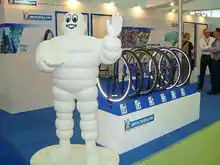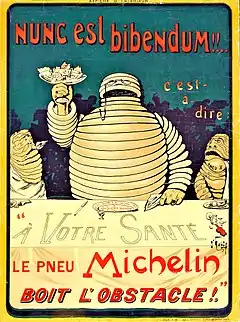Michelin Man
Bibendum (French pronunciation: [bibɛ̃dɔm]), commonly referred to in English as the Michelin Man or Michelin Tyre Man, is the official mascot of the Michelin tyre company. A humanoid figure consisting of stacked white tyres, the mascot was introduced at the Lyon Exhibition of 1894 where the Michelin brothers had a stand,[1] and is one of the world's oldest trademarks. The slogan Nunc est bibendum (Now is the time to drink) is taken from Horace's Odes (book I, ode xxxvii, line 1). He is also referred to as Bib or Bibelobis.[2]


Michelin dominated the French tyre industry for decades and remains a leading player in the market. It was one of the leading advertisers; to this day its famous guidebooks are widely used by travellers. Bibendum was depicted visually as a lord of industry, a master of all he surveyed, and a patriotic exponent of the French spirit. In the 1920s, Bibendum urged Frenchmen to adopt America's superior factory system, but to patriotically avoid using the "inferior" products of those factories. As automobiles became available to the middle classes, Michelin advertising likewise shifted downscale, and its restaurant and hotel guides likewise covered a broader range of price categories.[3]
Development
While attending the Universal and Colonial Exposition in Lyon in 1894, Édouard and André Michelin noticed a stack of tyres that suggested to Édouard the figure of a man without arms. Four years later, André met French cartoonist Marius Rossillon, popularly known as O'Galop, who showed him a rejected image he had created for a Munich brewery — a large, regal figure holding a huge glass of beer and quoting Horace's phrase Nunc est bibendum ("Now is the time for drinking").[4] André immediately suggested replacing the man with a figure made from tyres. Thus O'Galop transformed the earlier image into Michelin's symbol. Today, Bibendum is one of the world's most recognised trademarks, representing Michelin in over 150 countries.
The 1898 poster showed him offering the toast Nunc est bibendum to his scrawny competitors with a glass full of road hazards, with the title and the tag C'est à dire : À votre santé. Le pneu Michelin boit l'obstacle ("That is to say: Here's to your health. The Michelin tyre drinks up obstacles").[5] The character's glass is filled with nails and broken glass.[6] The implication is that Michelin tyres will easily take on road hazards.
The company used this basic poster format for fifteen years, adding its latest products to the table in front of the figure. It is unclear when the word "Bibendum" came to be the name of the character himself. At the latest, it was in 1908, when Michelin commissioned Curnonsky to write a newspaper column signed "Bibendum". In 1922, Michelin ran a contest for "naming the Michelin Tire Man" in the United States.[7]
From 1912 onwards, tyres became black in colour because carbon was added as a preservative and a strengthener to the basic rubber material. Before then, they were a gray-white or light and translucent-beige colour. Bibendum's appearance also changed, becoming black. Though Michelin briefly featured him that way in several print ads, it quickly changed back his appearance, citing printing and aesthetic issues for the change, and not racial concerns as commonly believed.[8]
The name of the plump tyre-man has entered the language to describe someone obese or wearing comically bulky clothing (e.g. "How can I wrap up warmly without looking like the Michelin Man?").[9]
Bibendum's shape has changed over the years. O'Galop's logo was based on bicycle tyres, wore pince-nez glasses with lanyard, and smoked a cigar. By the 1980s, Bibendum was being shown running, and in 1998, his 100th anniversary, a slimmed-down version became the company's new logo. He had long since given up the cigar and pince-nez. The slimming of the logo reflected lower-profile, smaller tyres of modern cars. Bib even had a similar-looking puppy as a companion when the duo were CGI animated for recent American television advertisements.
A history of the emblem was written by Olivier Darmon and published in 1997: Le Grand Siècle de Bibendum; Paris: Hoëbeke.[10]
In popular culture

The "Bibendum chair" was designed by Eileen Gray in 1925.
Cayce Pollard, the main character of William Gibson's novel Pattern Recognition, has a strong aversion to corporate brands and logos. The sight of Bibendum in particular gives her panic attacks.
Bibendum made a brief guest appearance in the Asterix series, as the chariot-wheel dealer in certain translations, including the English one, of Asterix in Switzerland. (The original French version used the Gaulish warrior mascot of French service-station company Antar.)
Michelin sued the performance artist Momus for releasing a song about the trademarked Michelin Man.
French reggae band Tryo sang about Bibendum on their album Grain de Sable. 'Monsieur Bibendum, il est vraiment énorme / Monsieur Bibendum, le bonheur en personne' ('Mr Bibendum, he is truly enormous, Mr Bibendum; happiness personified').
In the 2009 animated, Academy Award-winning satire Logorama, a series of Bibendums play police detectives, a sheriff, and a squad of SWAT personnel who all work together to try to bring down a psychotic, ultraviolent criminal played by Ronald McDonald.
In Season 17 Episode 6 of Family Guy, "Stand by Meg", the Michelin Man was "murdered" by Chris Griffin on behalf of "Mr. Firestone". He later shows up at the Griffin house with the police, pointing to Chris as "the one who popped me".
In the French dubbed version of Ghostbusters the giant Stay Puft Marshmallow Man is named "Bibendum Chamallow" ("chamallow" was originally a confectionery marketed in France under this name, which vaguely resembles the American marshmallow). LEGO released the Stay Puft Bibendum Chamallow minifigure in its 2015 edition of the fun pack set.
References
- "L'Aimable Mons. Bibendum or Quelques Precisions sur le Guide Michelin". The Motor. nbr 3503: Page 41. 9 August 1969.
- "Michelin Corporate - Bibendum, the Michelin man, the living tyre". Archived from the original on 2010-06-18. Retrieved 2010-05-28.
- Stephen L. Harp, Marketing Michelin. Advertising and Cultural Identity in Twentieth-Century France (Johns Hopkins University Press, 2001)
- Horace, Odes, Book 1, Poem 37.
- Cross, Mary (2002). A Century of American Icons: 100 Products and Slogans from the 20th-Century Consumer Culture. Greenwood Press. pp. 31–34. ISBN 978-0313314810. Retrieved 4 September 2020.
- Dotz, Warren; Morton, Jim (1996). What a Character! 20th Century American Advertising Icons. Chronicle Books. p. 25. ISBN 0-8118-0936-6.
- advertisement, Saturday Evening Post 194:56 (March 4, 1922), p. 53
- "Michelin Man: The Inside Story - September 19, 2005".
- Brodkin, Jon (2006-10-06). "Kenny has a big pair of gloves to fill on Ireland's twin mission". The Guardian. London. Retrieved 2010-05-12.
- Also in English and German: One Hundred Years of Michelin Man; translated from the French by Bernard Besserglik; Paris: Hoëbeke, 1997; Michelin Man: 100 years of Bibendum; London: Conran Octopus, 1998.--Bibendum: ein Jahrhundert Geschichte; aus dem Französischen von Herta Luise Ott.
External links
| Wikimedia Commons has media related to Bibendum. |
- Bibimage.com, Unofficial site dedicated to Bibendum. (in French)
